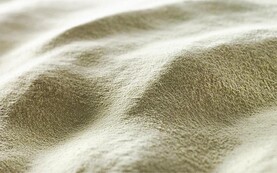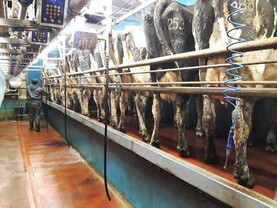Grazing: Most farmers are counting down the days to when cows will be housed full-time. Weather has already forced some herds indoors.
Others are taking it day by day. Weather and ground conditions are one thing, but grass availability is another.
It’s far more valuable to have grass in the spring than to continue grazing in the autumn.
Yet, I still see many farmers kinking out the whole farm in the back end. As a rough guide, you should only graze 20% to 30% of the farm in November.
The rest should be closed and left for the spring.
To put a bit more science on this, you should be closing the farm at an average farm cover of between 650kg/ha and 950kg/ha on 1 December. That’s the average of all grass covers on the farm.
Even if you don’t measure grass routinely, it would be well worth your while doing a grass walk now to know where you’re at.
Those that calve a bit later or have a lower stocking rate can get away with closing at a lower cover.
Higher-stocked farmers whose herds calve earlier need to carry over a higher cover, which brings its own problems with grass covers decaying over winter and higher covers harder to graze in spring. Only those on dry land should consider carrying over higher covers. Don’t forget, last spring was abnormally good.
Indoor milking: As cows are being housed at this time, the diet of the dairy cow will change from grass and meal to silage and meal.
The energy level in silage is less than that of grass, so milk volume and constituents usually drop when silage is in the diet. There are a few ways to respond to this.
Drying off the lowest-yielding cows is probably prudent as the cost of feeding meal and silage to these animals is more than the value of the milk they are producing.
These cows are usually the younger animals that could do with a longer dry period anyway. Then look at the diet of the rest of the cows.
They’ll milk better on good-quality silage, but don’t use it all up now as you’ll need good-quality silage (one round bale per cow) for the spring.
When cows are inside, the level of meal feeding and the protein content of the meal can be increased, but you need to be certain you’re getting a response to this.
With base milk in or around 30c/l and the average herd only getting 3 or 4c/l above this based on constituents, it’s a marginal enough sum.
For me, I think drying off 10% of the lowest yielding cows every week and keeping meal feeding in the 2 to 3kg/cow range is probably a happy medium.
Building: This is the time of year when a lot of farmers make decisions about investments. They tend to have a better idea of how much free cash is available.
Speaking to people working in lending, they say that almost every building project ends up costing more than anticipated.
Most farmers still don’t include a contingency when setting a budget.
The other thing to keep in mind is when spending money on a project, it’s easy to get into the habit of spending money, often on things you don’t really need. Keep this in mind when planning capital expenditure.
Read more
Grassland Farmer of the Year finalists
Dairy management: set yourself up for early turnout
Grazing: Most farmers are counting down the days to when cows will be housed full-time. Weather has already forced some herds indoors.
Others are taking it day by day. Weather and ground conditions are one thing, but grass availability is another.
It’s far more valuable to have grass in the spring than to continue grazing in the autumn.
Yet, I still see many farmers kinking out the whole farm in the back end. As a rough guide, you should only graze 20% to 30% of the farm in November.
The rest should be closed and left for the spring.
To put a bit more science on this, you should be closing the farm at an average farm cover of between 650kg/ha and 950kg/ha on 1 December. That’s the average of all grass covers on the farm.
Even if you don’t measure grass routinely, it would be well worth your while doing a grass walk now to know where you’re at.
Those that calve a bit later or have a lower stocking rate can get away with closing at a lower cover.
Higher-stocked farmers whose herds calve earlier need to carry over a higher cover, which brings its own problems with grass covers decaying over winter and higher covers harder to graze in spring. Only those on dry land should consider carrying over higher covers. Don’t forget, last spring was abnormally good.
Indoor milking: As cows are being housed at this time, the diet of the dairy cow will change from grass and meal to silage and meal.
The energy level in silage is less than that of grass, so milk volume and constituents usually drop when silage is in the diet. There are a few ways to respond to this.
Drying off the lowest-yielding cows is probably prudent as the cost of feeding meal and silage to these animals is more than the value of the milk they are producing.
These cows are usually the younger animals that could do with a longer dry period anyway. Then look at the diet of the rest of the cows.
They’ll milk better on good-quality silage, but don’t use it all up now as you’ll need good-quality silage (one round bale per cow) for the spring.
When cows are inside, the level of meal feeding and the protein content of the meal can be increased, but you need to be certain you’re getting a response to this.
With base milk in or around 30c/l and the average herd only getting 3 or 4c/l above this based on constituents, it’s a marginal enough sum.
For me, I think drying off 10% of the lowest yielding cows every week and keeping meal feeding in the 2 to 3kg/cow range is probably a happy medium.
Building: This is the time of year when a lot of farmers make decisions about investments. They tend to have a better idea of how much free cash is available.
Speaking to people working in lending, they say that almost every building project ends up costing more than anticipated.
Most farmers still don’t include a contingency when setting a budget.
The other thing to keep in mind is when spending money on a project, it’s easy to get into the habit of spending money, often on things you don’t really need. Keep this in mind when planning capital expenditure.
Read more
Grassland Farmer of the Year finalists
Dairy management: set yourself up for early turnout






 This is a subscriber-only article
This is a subscriber-only article









SHARING OPTIONS: